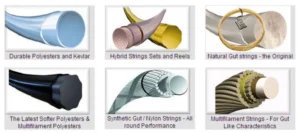Your ability to play tennis can be greatly enhanced by selecting the appropriate tennis racquet. Although it may not seem like it at first, the various components that make up a racquet have a significant impact on your playing style. Your preference for racquets will probably have an impact on your playing style. Selecting a racquet that meets your individual demands becomes increasingly evident when you take into account factors like string pattern, head size, weight, balance point, swing weight, grip size, string material, string tension, string gauge, and frame stiffness. Perhaps you’re looking for power in a racquet. Control may be preferred by others. Naturally, you may always locate a racquet that has a good ratio of both. Having said that, today we’ll be teaching you how to select a tennis racquet.
How to Select a String Pattern for Your Tennis Racquet
The open string pattern and the closed string pattern are the two different kinds of string patterns. You question, what makes the two different from each other? Here, let’s have a look. There are fewer cross strings that intersect when using a racquet with an open string arrangement. The 16×18, for instance, is a racquet with an open string design. Conversely, a racquet with a closed string design, like an 18×20 pattern, has more cross strings that intersect.
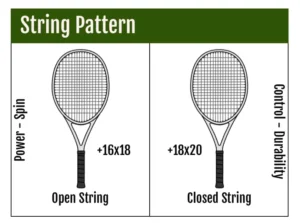
What difference does it make now whether a racquet has a closed or open string pattern?
To address that, an open string racquet naturally provides a player with additional force and spin when striking the ball because of its increased elastic properties. Imagine that a ball bounces back with more force when there are fewer intersections and wider space between the threads. In addition to offering more power and spin, an open string pattern is also favored by many because it improves feel for the ball.
There is a drawback to this kind of string arrangement, though. Because there are fewer cross strings on an open string racquet, it is less sturdy and the strings are more likely to break. However, for players who require maximum power, especially in younger players, an open string design racquet is an absolute must.
The closed string pattern comes next. This results in a sturdy racquet face that breaks less frequently since there are more cross strings available. But this increased longevity also means that there is a price for more power and spin. Although an 18×20 racquet won’t deflect the ball as much as an open string racquet, players who want control sometimes choose it because of its enhanced toughness, which can save their lives in situations where they already hit hard.
Size of Head
The head size is the most important consideration when selecting a tennis racquet. The head size, which is defined as the dimensions of the racquet face (frame and strings), has a direct bearing on the amount of power you can generate. This is due to the fact that a bigger head size provides a wider sweet spot and hitting area, which facilitates hitting balls in the racquet’s center.
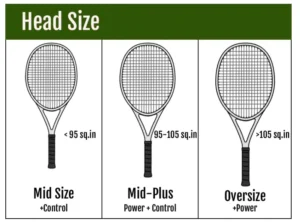
The size of a standard racquet’s head can vary from 85 to 135 square inches. There are three divisions within this range: oversize, mid-plus, and mid size. Beginners typically like larger head sizes because they provide more power, but more seasoned players choose smaller head sizes because they provide greater control.
Racquets above 105 square inches are regarded as oversized. Mid-size racquets are less than 95 inches in square, whereas mid-plus racquets are between 95 and 105 inches.
Point of Balance/Weight
You may probably notice a racquet’s weight when holding it in your hands. A racquet offers control and power, as you may already be aware, and the weight of your racquet will directly impact each of these attributes. Heavy racquets have greater power, offer greater stability, and produce less shock. Lighter racquets are more maneuverable and allow for faster swing speeds.
Weight is divided into three primary categories: heavy (head-light), medium (balanced), and lightweight (head-heavy). The concept here is that while most racquets have a hefty head to generate strong shots, a racquet’s weight category is determined by the weight of the handle. Since the head weighs more than the handle, a racquet with a hefty head and a light handle is said to be head-heavy.
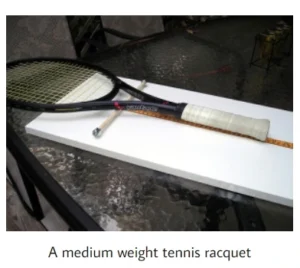
By measuring the balance point of a racquet, you can tell if it is head-light, head-heavy, or balanced. Where a racquet is completely balanced on its length is known as the balance point. A racquet on a straight rod can be adjusted to the point where it doesn’t tilt to either side to achieve this. Head-heavy balance points are located more than halfway up the racquet, head-light balance points are located less than halfway up, and balanced balance points are located in the middle. Each point is equivalent to 1/8 of an inch when calculating the balance point. Therefore, the balance point of an 8-point head-heavy racquet is 1 inch above the middle, whereas the balance point of an 8-point head-light racquet is 1 inch below the middle.
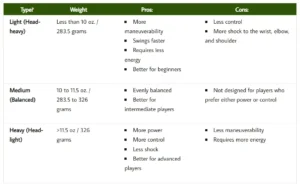
So what makes a racquet light, medium, or heavy?
You can familiarize yourself with the different categories with this chart:
Remember, though, that swing weight and racquet weight are not the same. While the significance of racquet weight is debatable—heavier racquets will require more effort to handle if you weigh less—your ability to swing your racquet on the court will primarily depend on its swing weight.
Swing Mass
Swing weight, which ranges from 0 to 1000, provides a sense of how heavy a racquet feels to swing. For this reason, while choosing a tennis racquet, swing weight may be considered to be more important than strung weight. A higher number indicates greater difficulty in swinging the racquet, while a lower level indicates ease of use. Nowadays, most racquets have a swing weight of between 280 and 350. The weight of the racquet, its length, its balancing point, and the size of its head all affect its swing weight.
More spin and racquet head speed would be benefits of a reduced swing weight. A lower swing weight can be any value less than 310. A higher swing weight, which is regarded as having a rating above 330, has the advantages of more power and stability. A medium swing weight, which ranges from 311 to 329, offers you the best of both worlds.
Sizes of Grip
In essence, grip sizes are determined by hand sizes. Naturally, hands vary in size, so the key to choosing the proper grip size is to choose one that you can hold and use comfortably. Using the incorrect grip size can cause a variety of issues, including irritability, injuries to your hand, elbow, and shoulder, and decreased performance (power and control). It seems senseless to use the incorrect grip size, much
as how individuals don’t wear shoes that are too small for them.
The simplest method to discover your ideal grip size is to hold a racquet and see how comfortable it is for you. To find out your precise grip size, you can, if you’d like, do a number of tests (such as the ruler and index finger tests).
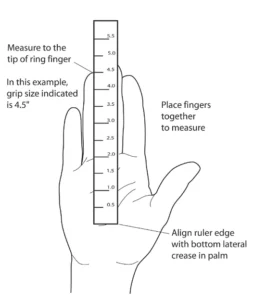
In the US, the most common grip sizes range from 4 inches (101.6 mm) to 4.75 inches (123 mm). Grip sizes are ranked from 0 to 5 in Europe. Typically, you can determine the grip size of a racquet by examining the neck or butt of the frame.
Your grip size may be determined here, since we go into great depth about it.
String Content
Basically, there are two types of materials used to make tennis racquet strings: gut or synthetic materials. Naturally, the sensation of striking a ball varies depending on the kind of tennis string used. The finest kind of string for you will rely on your own tastes.
Strings
However, we must discuss the many kinds of strings if we hope to create a comprehensive guide on selecting a tennis racquet. Let’s now examine each of them individually.
- Natural Gut: Since gut strings, often referred to as catgut, are composed of real animal gut and have been used since the invention of tennis racquets, they are also referred to as the “original.” Although sheep’s guts were once utilized, cow’s gut makes up the majority of gut strings used today. It is made by drying fibers taken from the intestines of cows, which have collagen that is resilient to elongation and contraction. Tennis strings made from animal intestine are the most efficient since it is the most durable material and provides the most energy return.

- Synthetic Gut: Nylon, the material used to make synthetic gut strings, typically has a single filament. There are many various alternatives available for synthetic gut strings, including textured coatings, colorants, and the use of Kevlar. These kinds of strings provide various features like spin, power, durability, and feel.

- Multi-Filament: Although multi-filament contains more than one filament, it is comparable to synthetic gut. This is one of the most well-liked strings after natural gut because it provides superior suppleness and a string that is similar to it. This kind of string is soothing on the arm because it is very soft. You obtain optimal performance all around when you use multi-filament strings.

- Nylon: The most widely used type of string in tennis is nylon, which is a simple all-around string. may have coatings that withstand wear. While it seems a little crisper than multi-filament, the material is not the softest and can still put pressure on the arm. The preferred string type for amateur players is this one.

- Polypropylene: For players who hit hard strokes but wish to avoid breaking strings frequently, polyester is an excellent choice because it is both extremely stiff and resilient. can enable increased control and topspin. Due to its capacity to produce more topspin, it is widely utilized in professional tennis.

- Kevlar: Though it’s also the most durable string on the market, kevlar is the stiffest. For musicians who frequently snap their strings, this is highly recommended since it makes it incredibly difficult to break. But this puts additional strain on the elbow, shoulder, and wrist due to its stiffness. It’s actually the riskiest string for developing tennis elbow, therefore you should only use it in a hybrid (typically with nylon) or if your arms are literally made of iron.

Tension
It’s critical to consider what string tension you desire when selecting a tennis racquet and having it strung at a store. You can pick between three different sorts of string tension: low, high, and a tension in between. String tension has a significant impact on the racquet’s feel and control.
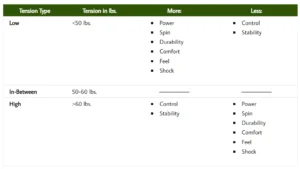
Your swing speed and the kind of strings you choose will determine what tension works best for you. High tension provides you with better stability and control, while low tension permits you to use more power, spin, and feel. To determine what works best for you, you’ll need to experiment with the string tension on your racquet.
String Gauge
The thickness of a string is known as its gauge, and it can have an impact on your racquet’s spin and feel. The most popular string gauges range from 15 to 18, with a rating system from 1 to 15. The letter L designates half-gauges, so a 16L is halfway between a 16 and a 17. Generally speaking, thinner strings perform better; a greater number indicates a thinner string. They offer more spin, power, elasticity, control, and superior feel. Naturally, thinner strings are more prone to breaking than thicker ones, so pick a gauge that fits your playing style.
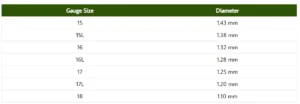
When the strings break quickly, you can determine the ideal string gauge for you by starting with a thin string and working your way down.
Frame Flexibility / Stiffness Rating
The rigidity of a racquet’s frame is measured. I mean, who would have guessed? Actually, most people probably are. However, why is the stiffness of a frame important? The most power can be delivered to the ball with a stiffer racquet since it bends less. This adds spin and reduces strain, but it also results in a greater energy loss for a racquet with greater flexibility. Choose a frame that is not too stiff since this will naturally put extra strain on the shoulder, arm, and wrist.
However, frame stiffness is mostly a personal choice, as various players have different requirements for comfort and control. Flex ratings for frames range from 0 to 100, with most racquets being rated between 50 and 80. Below 60 is a poor rating, 61–68 is a medium rating, and 69 and above are high ratings.

